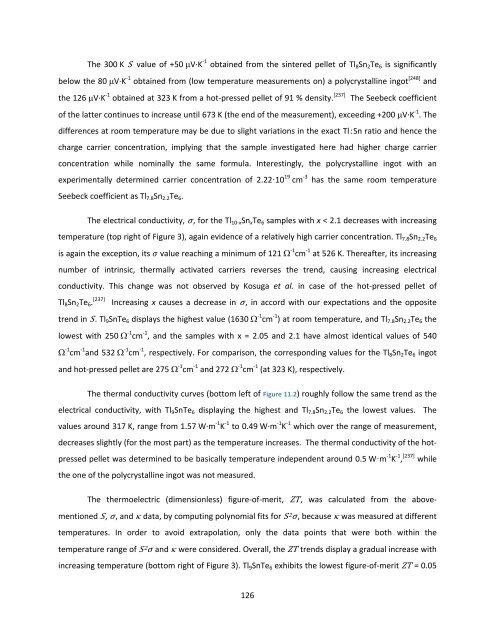Exploration and Optimization of Tellurium‐Based Thermoelectrics
Exploration and Optimization of Tellurium‐Based Thermoelectrics
Exploration and Optimization of Tellurium‐Based Thermoelectrics
You also want an ePaper? Increase the reach of your titles
YUMPU automatically turns print PDFs into web optimized ePapers that Google loves.
The 300 K S value <strong>of</strong> +50 V∙K ‐1 obtained from the sintered pellet <strong>of</strong> Tl8Sn2Te6 is significantly<br />
below the 80 V∙K ‐1 obtained from (low temperature measurements on) a polycrystalline ingot [248] <strong>and</strong><br />
the 126 V∙K ‐1 obtained at 323 K from a hot‐pressed pellet <strong>of</strong> 91 % density. [237] The Seebeck coefficient<br />
<strong>of</strong> the latter continues to increase until 673 K (the end <strong>of</strong> the measurement), exceeding +200 V∙K ‐1 . The<br />
differences at room temperature may be due to slight variations in the exact Tl:Sn ratio <strong>and</strong> hence the<br />
charge carrier concentration, implying that the sample investigated here had higher charge carrier<br />
concentration while nominally the same formula. Interestingly, the polycrystalline ingot with an<br />
experimentally determined carrier concentration <strong>of</strong> 2.22·10 19 cm ‐3 has the same room temperature<br />
Seebeck coefficient as Tl7.8Sn2.2Te6.<br />
The electrical conductivity, σ, for the Tl10‐xSnxTe6 samples with x < 2.1 decreases with increasing<br />
temperature (top right <strong>of</strong> Figure 3), again evidence <strong>of</strong> a relatively high carrier concentration. Tl7.8Sn2.2Te6<br />
is again the exception, its value reaching a minimum <strong>of</strong> 121 ‐1 cm ‐1 at 526 K. Thereafter, its increasing<br />
number <strong>of</strong> intrinsic, thermally activated carriers reverses the trend, causing increasing electrical<br />
conductivity. This change was not observed by Kosuga et al. in case <strong>of</strong> the hot‐pressed pellet <strong>of</strong><br />
Tl8Sn2Te6. [237] Increasing x causes a decrease in σ, in accord with our expectations <strong>and</strong> the opposite<br />
trend in S. Tl9SnTe6 displays the highest value (1630 ‐1 cm ‐1 ) at room temperature, <strong>and</strong> Tl7.8Sn2.2Te6 the<br />
lowest with 250 ‐1 cm ‐1 , <strong>and</strong> the samples with x = 2.05 <strong>and</strong> 2.1 have almost identical values <strong>of</strong> 540<br />
‐1 cm ‐1 <strong>and</strong> 532 ‐1 cm ‐1 , respectively. For comparison, the corresponding values for the Tl8Sn2Te6 ingot<br />
<strong>and</strong> hot‐pressed pellet are 275 ‐1 cm ‐1 <strong>and</strong> 272 ‐1 cm ‐1 (at 323 K), respectively.<br />
The thermal conductivity curves (bottom left <strong>of</strong> Figure 11.2) roughly follow the same trend as the<br />
electrical conductivity, with Tl9SnTe6 displaying the highest <strong>and</strong> Tl7.8Sn2.2Te6 the lowest values. The<br />
values around 317 K, range from 1.57 W∙m ‐1 K ‐1 to 0.49 W∙m ‐1 K ‐1 which over the range <strong>of</strong> measurement,<br />
decreases slightly (for the most part) as the temperature increases. The thermal conductivity <strong>of</strong> the hot‐<br />
pressed pellet was determined to be basically temperature independent around 0.5 W·m ‐1 K ‐1 , [237] while<br />
the one <strong>of</strong> the polycrystalline ingot was not measured.<br />
The thermoelectric (dimensionless) figure‐<strong>of</strong>‐merit, ZT, was calculated from the above‐<br />
mentioned S, σ, <strong>and</strong> data, by computing polynomial fits for S 2σ, because was measured at different<br />
temperatures. In order to avoid extrapolation, only the data points that were both within the<br />
temperature range <strong>of</strong> S 2σ <strong>and</strong> were considered. Overall, the ZT trends display a gradual increase with<br />
increasing temperature (bottom right <strong>of</strong> Figure 3). Tl9SnTe6 exhibits the lowest figure‐<strong>of</strong>‐merit ZT = 0.05<br />
126
















